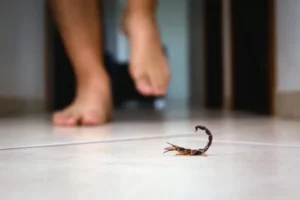Home / Blog / How to Get Rid of Carpet Moths
How to Get Rid of Carpet Moths

Scientifically reviewed by Daniel Baldwin, BCE, CCFS, CP-FS
-Published on May 1, 2023
-Updated on July 13, 2023
Carpet moths can infest your home, feeding on and destroying expensive rugs and furnishings. Find out how to get rid of carpet moths and ways to prevent future infestations.
What are carpet moths?
A carpet moth, also called a casemaking clothes moth, is an insect from the family Tineidae. Their larvae feed mainly on the natural fibers in rugs, clothing, and home furnishings, such as wool and silk. Carpet moths will also feed on synthetic materials if foods, sweat, or other nutritional sources of protein are present.
Carpet moths are ½” long with beige bodies. Their narrow wings have dark spots and tiny hair fringes at the ends. They prefer living in dark places that are usually not disturbed.
When carpet moths infest your home, the adults can lay 40-50 tiny eggs or more in dark, undisturbed areas, typically beneath or within rug fibers. After about a week, the eggs hatch into larvae that survive by eating keratin from animal-derived fabrics.
The larvae of carpet moths are white caterpillars that are ½” long. They envelop themselves in a tubular casing they carry behind them. This casing contains debris from the fibers they’ve fed on.
Carpet moths: where do they come from?
The usual habitat for carpet moths is outdoors, where they feed on natural animal fibers like the feathers found in a bird’s nest. In their natural habitat, carpet moths go through a few life cycles a year and remain dormant during the winter. But inside our cozy homes, they can be active throughout the year and manage multiple life cycles. Generally, when they enter homes, it is by accident.
What causes carpet moths in your home?
Carpet moths survive in your home because they’re attracted to the natural materials found in carpets, rugs, clothing, and other fibers in your home. They feed on the keratin present in these animal fibers.
How do carpet moths get in a house?
Carpet moths can easily fly into your home through open doors or windows. They can come in through an air duct or from a neighboring apartment in a building. Carpet moth eggs can also get inside by hitching a ride on clothing, used furniture, or on the soles of shoes or pets’ feet.
Are carpet moths the same as clothes moths?
Yes, both terms apply to the small, beige-colored moths that are found feeding on wool and silk textiles.
Signs of a carpet moth infestation
Signs of carpet moths include:
- Areas of a rug or other fabric have become threadbare.
- The larval shells that carpet moths discard over time lie around the edges of a room.
- Light gray eggs about 1 mm (.04 inches) appear in large numbers under carpeting or inside closets.
- You see adult moths flying around.
How do you check for carpet moths?
If you think carpet moths have infested your home, look at the top and bottom of your rugs for eggs or larvae. Check the edges of carpets and baseboards. Check in-between seams and creases of materials where carpet moth larvae like to feed. Inspect rooms and closets that don’t get a lot of sunlight and that you don’t use often. For wall-to-wall carpeting, use a tool to lift the outer edge of the carpet that lies along the baseboard.
A thorough inspection performed by a professional pest company, like Hawx Pest Control, will check for all signs of a carpet moth infestation.
How to get rid of carpet moths
If you already see ragged carpet edges, larvae, eggs, or adult moths flying around, an infestation exists that needs professional intervention. Adult moths reproduce rapidly, which means eggs can hatch into larvae numbering in the dozens or hundreds of these fabric-destroying pests.
How to get rid of moths in wool rugs and other carpets
- Clean rugs with a powerful vacuum. Get under rugs and furniture, as moths can hide within creases and folds.
- Shake rugs vigorously outdoors, then place them in the sunshine to air out to help destroy eggs.
- If the rugs can be washed, clean them using soap and water.
- Keep wool carpets as clean as possible with weekly vacuuming and brushing.
- Since carpet moths are strongly attracted to wool carpets that get little traffic, vacuuming, rotating, and walking on rugs makes them less appealing to pests.
- Remove spills as soon as they happen. Carpet moths will infest carpets with stains, particularly from food, urine, blood, or other animal sources.
These tips can aid in controlling carpet moths’ reproduction but won’t address a large infestation. Larvae may move on to another rug before you realize it, making a professional wool rug moth treatment necessary.
Carpet moth pest control services
If you’re experiencing an infestation of carpet moths in your home, contact the professionals at Hawx Pest Control. Call us today to obtain a free estimate to manage your current infestation and help prevent future problems.
For more on moth infestations of different types, read The Signs of a Moth Infestation.
Related Articles
Visit our blog to learn more.
→







